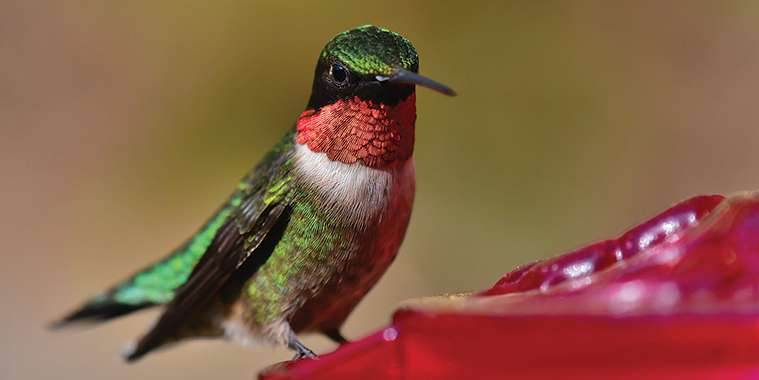Hummingbirds may be tiny, but they are fascinating and diverse creatures. Hummingbirds include the world’s smallest bird, the Bee Hummingbird of Cuba, and some of the strongest migrants. The Rufous Hummingbird undertakes the longest avian migration in the world, if based on distance traveled in proportion to body size. To sustain their supercharged metabolisms, hummingbirds must eat once every 10 to 15 minutes and visit between 1,000 and 2,000 flowers per day!
Hummingbirds are specialized for nectar-eating, which is why they have long bills and grooved tongues ideal for probing flowers. Sugary nectar supplies fast energy and makes up 90% of a hummingbird’s diet.
The Ruby-throated Hummingbird is the most common hummingbird species in North America and the only one known to nest in Manitoba. Weighing little more than a dime (2. -3.5g) it is the smallest breeding species in eastern North America. Males and females have iridescent green upperparts with whitish undersides. The brilliant red gorget of the adult male is distinctive when viewed in sunlight but appears black in shadow.
You can create a healthy environment for hummingbirds in your own yard with these steps:
• Fill your yard with native flowering plants, vines, shrubs and trees. Even one plant in a window box or hanging basket can help.
• Grow native plants like trumpet honeysuckle, bee balm and hummingbird sage, which provide much more nectar than hybrids and exotics.
• Plant native red or orange tubular flowers to attract hummingbirds, in addition to native plants rich in nectar.
• Group similar plants together and choose species with different blooming periods so that there will be a steady supply of flowers nearly year round.
• Leave some sticks and small branches on bushes and trees to enable ready perches for hummingbirds.
• Encourage your neighbors to make their yards hummingbird friendly. An entire corridor of habitat is much more valuable than scattered patches.
Make sure you have plenty of safe places for hummingbirds to rest and sleep in your yard. Hummingbirds often perch to rest or survey their territory; some spots should be in the open and obvious for territorial birds, while others should be in protected areas, hidden from view and buffered from any cooler overnight temperatures.
Hummingbirds need protein from pollen and insects to maintain their bodies and grow new feathers. Hummingbirds are specialized aerial hunters and can snatch small insects from the air. Hummingbirds also glean insects from leaves and from spider webs. To maintain a healthy ecosystem in your yard:
• Eliminate pesticides. Spiders and insects (arthropods) are an important part of an adult bird’s diet, and young hummingbirds still in the nest are almost exclusively fed arthropods.
• Make sure your yard contains insect-pollinated flowers as well as hummingbird-pollinated plants.
• Hang a basket with overripe fruit or banana peels close to a hummingbird feeder to attract tiny fruit flies.
• Hummingbirds like to bathe frequently — even in the pools of droplets that collect on leaves. Provide your yard with a constant source of water from a drip fountain attachment or a fine misting device. A misting device is an especially attractive water source for hummingbirds.
Backyard hummingbird feeders provide hummingbirds with nectar critical to their survival, especially during fall and spring migration. Follow these steps to ensure your yard is a safe and nutritious stopover for hummingbirds:
• Hang several feeders far enough apart that the hummingbirds cannot see one another; this will prevent one bird from dominating the rest.
• Fill the feeders with sugar water, made by combining four parts hot water to one part white sugar, boiled for one to two minutes. Never use honey (which can promote fungal growth), artificial sweeteners or red dye.
• Hang your feeders in the shade to prevent the sugar solution from fermenting.
• Be sure to change the sugar water regularly —before it gets cloudy, or about twice a week in warm weather.
• Clean the feeders with a solution of one part white vinegar to four parts water about once a week. If your feeder has become dirty, try adding some grains of dry rice to the vinegar solution and shake vigorously. The grains act as a good abrasive.
• Rinse your feeder well with warm water three times before refilling with sugar solution.
DIY Hummingbird Feeder
Supplies:
• 3 small plastic water bottles, empty and with labels removed
• 3 yellow silicon or plastic drinking straws with a bend
• 3 disposable plastic red bowls (you could also use red plastic plates)
• Electric drill with 1/8” bit
• Hole punch
• 12 gauge craft wire
• Rubber band or wire
• White glue
• Scissors
Instructions:
1. Cut out the flat bottom of each bowl, then trace the cap of a bottle onto it. Cut around the traced circle to create a flower shape.
2. Use the drill to create a hole in the top of each bottle cap that is just wide enough for a straw to fit through.
3. Punch a hole in the center of each red plastic flower and thread each one onto the end of a straw. Insert the straw into the cap of a bottle and seal with white glue. Make sure the bend of the straw is just outside the cap opening so the straw bends at an angle as it comes out of the bottle. This is where the hummingbird will drink from!
4. Arrange the flower so it is at the end of the straw’s bend to attract the hummingbirds. Glue in place. (You’ll need to remove the cap to add nectar to the bottles, so keep that in mind as you apply glue!) Let dry overnight.
5. Once dry, wrap the wire around the neck of a bottle, then pull it up to create a hanger for the bottle.
7. You can attach all three of the bottles together in a pyramid shape with a strong rubber band or wire. Or you can hang each separately in different parts of your yard.
Hummingbird Nectar
• 1/4 cup refined white sugar
Note: Plain white table sugar is sucrose, which, when mixed with water, very closely mimics the chemical composition of natural nectar.
• 1 cup boiling water
Note: There’s no need for red dye. Red colouring isn’t necessary and the chemicals could be harmful.
Instructions:
1. Mix sugar and boiling water until sugar is dissolved. Double recipe if needed. Extra nectar can be stored in the refrigerator.
2. Cool the nectar and fill feeder.
3. Hang your feeder outside and wait for the hummingbirds to come!
For more information about helping to sustain hummingbird populations and their habitats visit audubon.org



